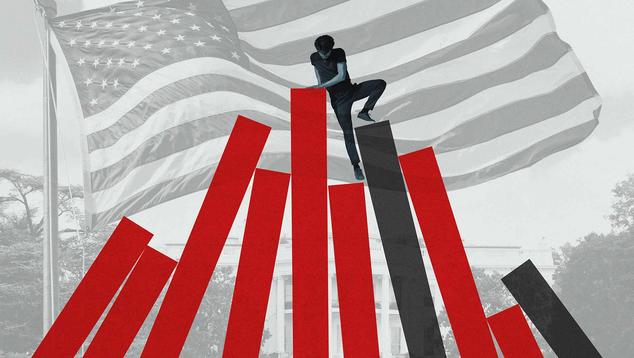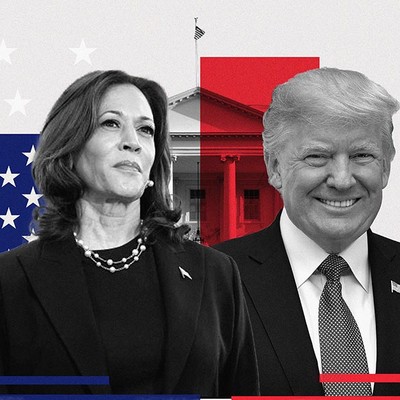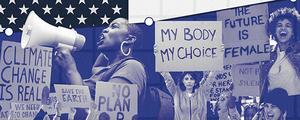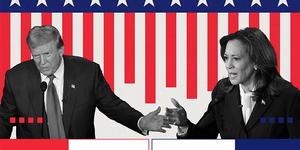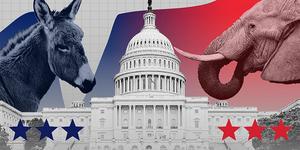WASHINGTON, D.C. -- Nearly all Gallup measures that have shown some relationship to past presidential election outcomes or that speak to current perceptions of the two major parties favor the Republican Party over the Democratic Party. Chief among these are Republican advantages in U.S. adults’ party identification and leanings, the belief that the GOP rather than the Democratic Party is better able to handle the most important problem facing the country, Americans’ dissatisfaction with the state of the nation, and negative evaluations of the economy with a Democratic administration in office.
The following is a review of these key measures in 2024, primarily from a Sept. 3-15 Gallup poll, compared with the same measures in past presidential election years.
Party Identification and Leaning
More U.S. adults identify as Republican or say they lean toward the Republican Party (48%) than identify as or lean Democratic (45%). Those figures are based on an average of Gallup polls taken during the third quarter (July to September) to minimize poll-to-poll variation in party identification estimates and to provide more reliable comparisons across presidential years given the different timings of the two major party conventions in July, August or September.
Party affiliation and voting are strongly predictive of individuals’ vote choices, with the vast majority of identifiers and leaners voting for the candidate of their preferred party. At the aggregate level, there are typically more Democrats and Democratic leaners than Republicans and Republican leaners in the U.S. adult population. Democrats have won presidential elections in years in which they had larger-than-normal advantages in party affiliation, including 1992, 1996, 2008, 2012 and 2020.
In years when the advantage was narrower -- 2004 and 2016, for example -- Republicans won in the Electoral College if not also the popular vote.
Republicans previously have not had an outright advantage in party affiliation during the third quarter of a presidential election year, and they have rarely outnumbered Democrats in election and nonelection years over the past three decades.
Party Performance on Issues
Three separate measures of party performance on issues favor the Republican Party by at least a modest margin.
By 46% to 41%, Americans say the Republican Party is better able than the Democratic Party to address what they think is the most important problem facing the country. The top issues Americans currently name as the most important are ones that tend to favor the GOP, including the economy (24%), immigration (22%), the government (17%) and inflation (15%).
This measure has been highly predictive of election outcomes in Gallup trends dating back to 1948. The party rated as better at handling the most important problem has won all but three presidential elections since that year. The question was not asked in 2000, and the two parties tied in 1980, when inflation was the top issue. The only time the measure was out of sync with the outcome was in 1948, when Americans believed the Republican Party was better able to handle the most important problem (international issues) but returned Democratic incumbent Harry Truman to office.
Gallup also tracks perceptions of which party can best handle economic and international matters, broadly. Americans currently give the Republican Party a six-percentage-point edge, 50% to 44%, as the party they think would do a better job of keeping the country prosperous. Gallup has asked this question since 1951. In 16 presidential elections since then when one party has had at least a minimal advantage on this measure, that party has won 12 times. The exceptions were 1952, 1968, 1980 and 2000. The question was not asked in 2004, and the parties were tied in 1956.
Republicans hold a more substantial advantage of 14 points (54% to 40%) as the party Americans believe is better able to keep the nation safe from terrorism and other international threats. Republicans have led on this question all years it has been asked (dating back to 2002) except 2007 and 2012.
Gallup has a limited history of asking this question in presidential election years. The 14-point Republican lead this year is larger than in any previous presidential election year. The prior highs were seven points in 2008 (a year Republicans lost) and 2016 (a year Republicans won). In 2012 (when the parties were tied) and 2020 (when Republicans had a four-point advantage), the Democratic candidate won the presidential election.
Economic Confidence
Gallup’s Economic Confidence Index is currently at -28, indicating Americans’ attitudes about the economy are negative, on balance. The rating is derived from the 22% of Americans describing current economic conditions as “excellent” or “good” versus the 48% saying they are “poor,” and the 32% believing the economy is “getting better” versus the 62% saying it is “getting worse.”
In incumbent election years, a -28 economic confidence score would be closer to what it has typically been in losing (1992, 2008, 2016) rather than winning (1996, 2004, 2012) years for the president’s party. In 2020, Americans’ evaluations were essentially neutral when Donald Trump lost, though other incumbent presidents won when there were similar levels of economic confidence.
National Satisfaction
Twenty-two percent of Americans are satisfied with the way things are going in the United States at this time. Satisfaction levels this low have been associated with incumbent presidents losing their reelection bids in 1980 (19%), 1992 (22%) and 2020 (28%).
In election years when incumbents have not sought reelection, satisfaction has been less strongly related to the eventual outcome. The 1988 and 2008 elections followed the general pattern, with the president’s party winning the former when the majority of Americans were satisfied and losing the latter with satisfaction near record lows. However, in 2000, Americans were highly satisfied, but the incumbent Democratic Party lost a close election in the Electoral College. The incumbent Democratic Party also lost the 2016 election (also in the Electoral College) with more middling levels of satisfaction.
Presidential Job Approval
President Joe Biden’s decision to withdraw from the 2024 presidential race has moved presidential job approval from arguably the most important election indicator this year to one of secondary importance. At 39% job approval, Biden is well below the 48% threshold for past presidents who were reelected. The 2024 Republican presidential nominee, Donald Trump, lost the 2020 election when 46% approved of the job he was doing as president.
Biden’s unpopularity could still affect the election to the extent voters transfer their frustrations with the Biden administration to Vice President Kamala Harris. For her part, 44% of U.S. adults approve of the job she is doing as vice president, down slightly from a 47% reading in August.
In presidential election years when the incumbent was not running for reelection, the opposition party won all but the 1988 election. These losses occurred whether the incumbent president was popular (1960, 2000 and 2016) or unpopular (1952, 1968 and 2008) at the time of the election. All of those elections, unlike the current one, came after the incumbent had been elected to serve a second term as president in the prior election.
Party Favorable Ratings
One area where the Republican Party does not have an advantage over the Democratic Party this year is in party favorable ratings. The September Gallup poll finds 43% of Americans saying they have a favorable opinion of the Republican Party and 42% of the Democratic Party.
In many presidential election years, like now, the parties had similar favorable ratings. In the years in which one party had an advantage -- 1996, 2004, 2008, 2012 and 2016 -- the party with the higher favorable rating won all but one (2016).
Preference for Government Activity
Americans generally express a preference for a limited government role, the traditional Republican position, when they are asked whether the government is doing too many things that should be left to individuals and businesses (55%) or should do more to solve the country’s problems (41%). Since opinions on this matter have been fairly consistent over time, they tend to have little relationship to election outcomes.
However, it is notable that in 1992 and 2020, the only two election years when more Americans preferred an active government role, the Democratic Party candidate defeated a Republican incumbent.
Congressional Job Approval
All seats in the House of Representatives and approximately one-third of U.S. Senate seats are up for election this year. Congress remains unpopular, with 20% approving and 75% disapproving of the job it is doing, which theoretically could make incumbent members of Congress vulnerable. To the extent Americans’ frustrations with Congress influence their vote decision, it is unclear how those numbers will translate because the Republicans have a majority in the House of Representatives and Democrats are the majority party in the Senate.
Nevertheless, the current level of congressional approval is remarkably similar to what it has been in every congressional election cycle since 2008, ranging between 18% and 21%.
Divided Government Preference
Americans have typically not held a clear preference for having a unified versus divided party government. The 41% who this year say having the same party control Congress and the presidency ties with 2020 as the highest in Gallup’s trend. Thirty percent say it makes no difference whether the government is unified or divided, while 23% say having different parties control Congress and the presidency is preferable.
Americans have been slightly more likely to say that a unified government is better in presidential compared with non-presidential election years.
Bottom Line
The political environment suggests the election is Trump’s and Republicans’ to lose. Nearly every indicator of the election context is favorable to the Republican Party, and those that aren’t are essentially tied rather than showing a Democratic advantage. Nevertheless, the two major party presidential candidates have similar favorable ratings in Gallup’s September poll, echoing presidential preference polls that suggest a neck-and-neck race between Trump and Harris.
It is possible that Americans’ voter preferences may align better with their views of the state of the nation between now and Election Day. Trump led in most presidential preference polls this summer when Biden was the presumptive Democratic nominee and Americans’ unhappiness was focused on the incumbent president. The election results will reveal the extent to which Harris, the incumbent vice president, is saddled with Americans’ frustrations with the current administration or is able to rise above those.
It may be the case that Americans want to go in a different direction after previously voting against a second Trump term in 2020. If Trump were to lose, it suggests that concerns about his style, character, temperament, felony charges and convictions, and age outweigh Americans’ anxieties about the state of the nation.
To stay up to date with the latest Gallup News insights and updates, follow us on X @Gallup.
Explore President Biden's approval ratings and compare them with those of past presidents in the Gallup Presidential Job Approval Center.
Learn more about how the Gallup Poll Social Series works.
View complete question responses and trends (PDF download).
